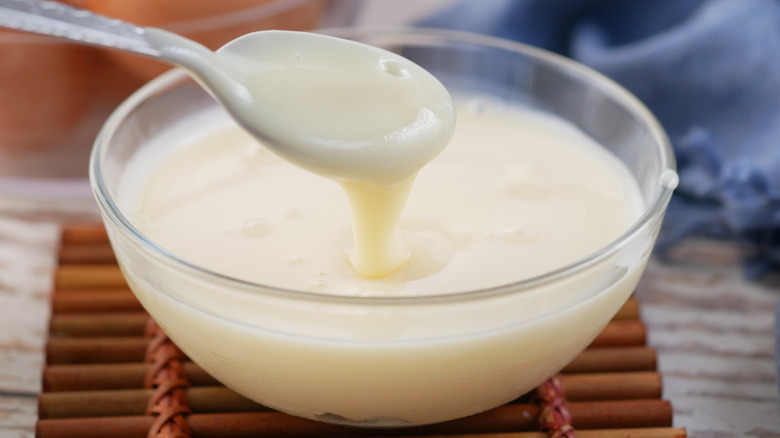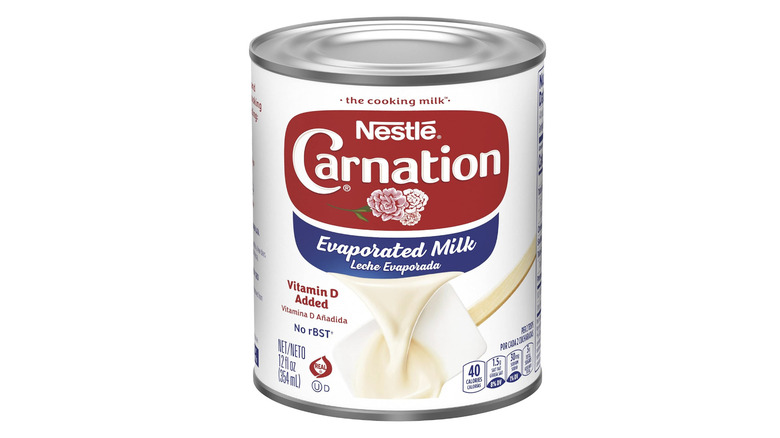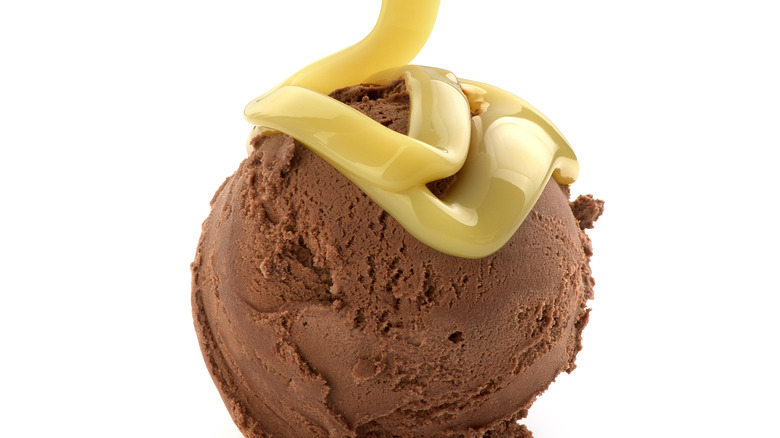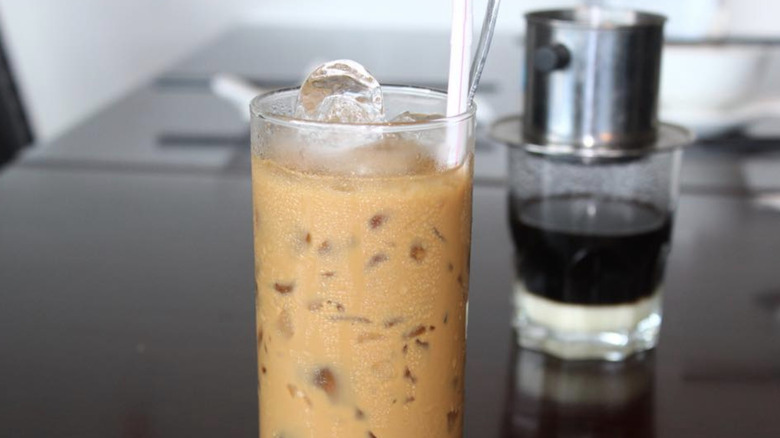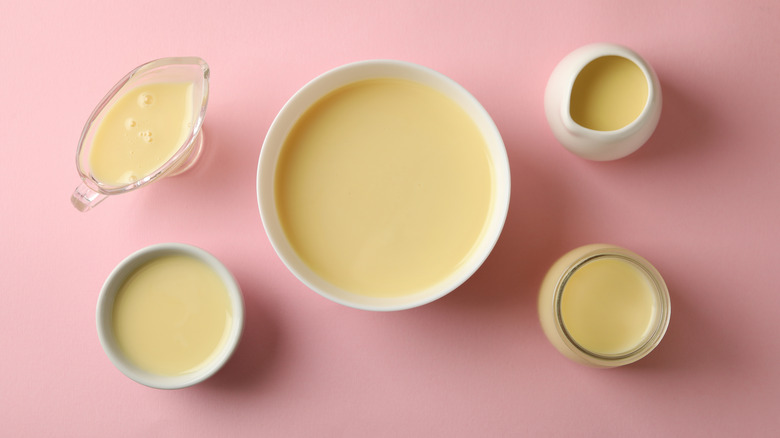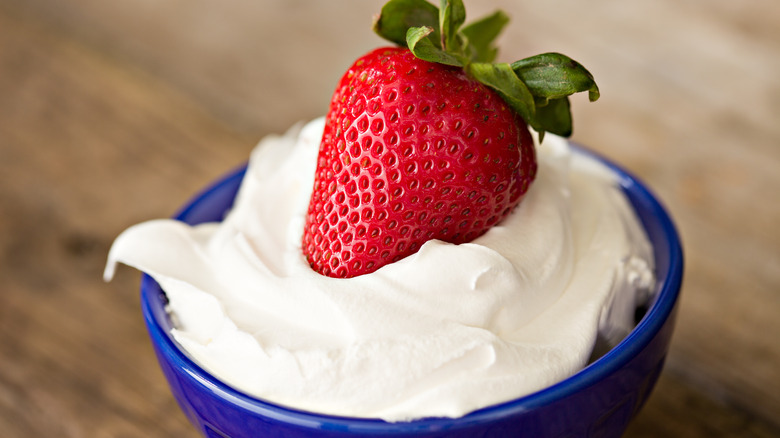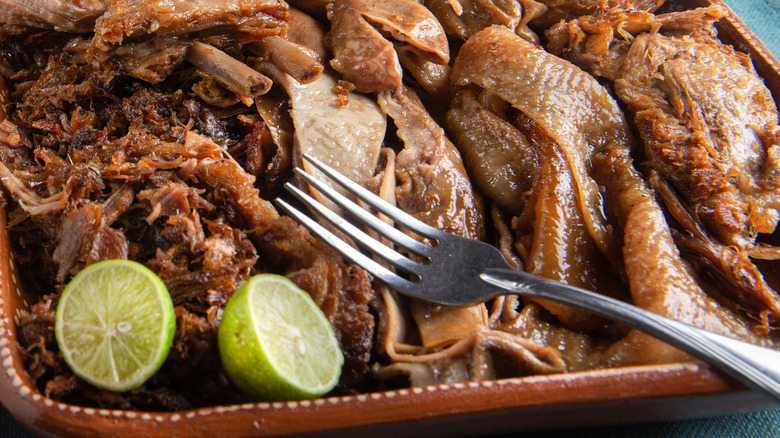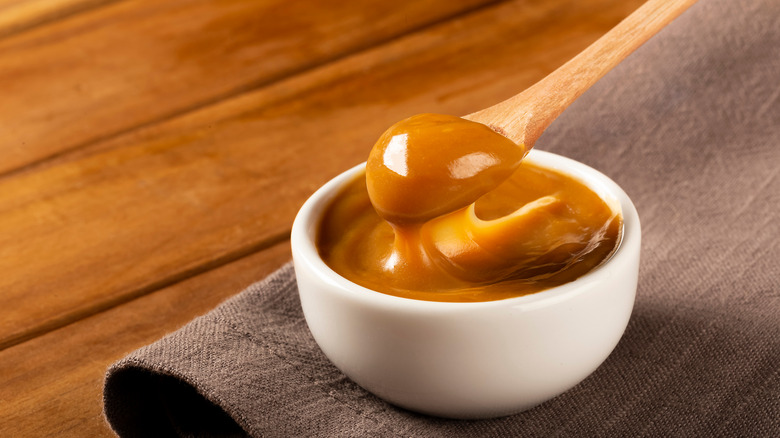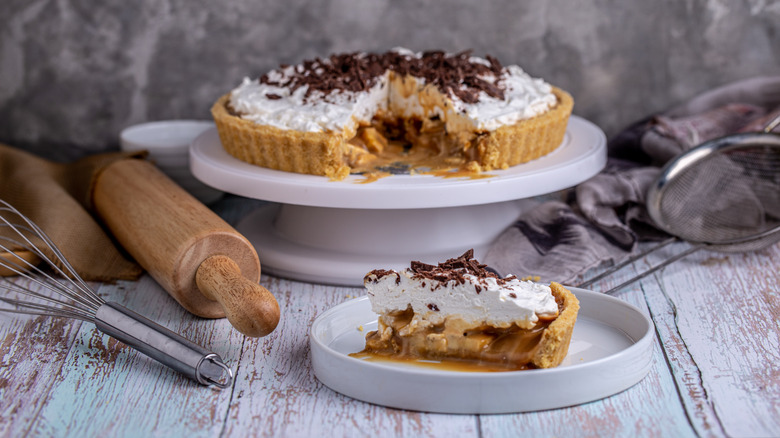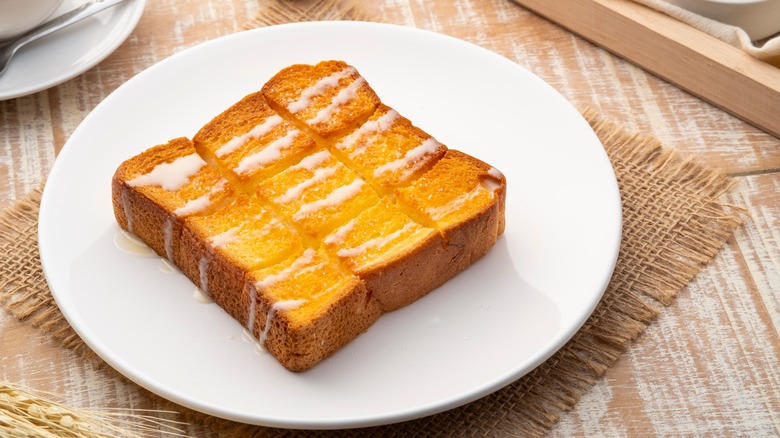10 Mistakes Everyone Makes When Cooking With Condensed Milk
We may receive a commission on purchases made from links.
Invented in 19th-century France as a method to preserve milk, condensed milk quickly found its way across the Atlantic to the U.S. The sweet concoction was first commercialized by the American inventor Gail Borden in the 1850s. The convenience and long shelf life of condensed milk made it an invaluable resource during times of war and in homes that lacked access to fresh milk.
In simple terms, condensed milk is a thick, sweetened mixture that's created by simmering fresh milk and sugar until it reduces through evaporation. This process intensifies the sweetness of condensed milk while also giving it a coveted velvety consistency. Commonly used as a key ingredient in desserts such as cakes and ice creams, condensed milk can contribute to both the flavor and texture of these treats. However, the versatility of condensed milk extends beyond treats, with the dairy product sometimes also lending itself to savory dishes such as glazes, sauces, and marinades.
There's little doubt that condensed milk holds a significant place in the culinary world. Nevertheless, many of us are not using it to its full potential. Luckily, we're here to help. These are of the common errors to avoid when cooking with condensed milk.
1. Confusing condensed milk with evaporated milk
If you've ever returned from a shopping trip only to discover that you've picked up a can of evaporated milk instead of the condensed stuff, rest assured that you're not alone. The two milk types not only look similar but are also often packaged in nearly identical cans. Adding to the confusion, the names of these milky products don't offer clear clues about the significant differences between the two. In reality, while both condensed milk and evaporated milk are types of concentrated milk, they are vastly different in their taste and culinary applications. Perhaps the only thing that's similar between the two products is the fact that both have had around 60% of their water removed.
Condensed milk's sweet flavor and syrupy consistency are due to the addition of sugar during the manufacturing process. The product's high sugar content also means that it has a relatively long shelf life. Thanks to its sweet flavor, condensed milk is commonly used in desserts, such as fudge, cakes, and ice cream.
In contrast, evaporated milk doesn't contain any added sugar. Sometimes referred to as unsweetened condensed milk, evaporated milk is creamier than regular milk, making it a favorite addition to both sweet and savory recipes like mashed potatoes, puddings, and sauces.
2. Not making your own condensed milk
If a recipe calls for condensed milk and you don't have any of the dairy product on hand, don't despair just yet. Making condensed milk in your own kitchen is surprisingly easy, so long as you have the time and a few basic ingredients. In fact, you only need two ingredients: milk and sugar. While it's best to use evaporated milk to make condensed milk, most types of milk will work in a pinch. To make condensed milk, simply boil the milk and sugar in a saucepan until it thickens. If the final result is lumpy, strain the mixture through a sieve. Some recipes also call for a little baking soda to make the condensed milk creamier once it's taken off the heat.
Vegans and individuals with lactose intolerance can make their own dairy-free condensed milk. Although the recipe remains largely unchanged, dairy-free condensed milk substitutes traditional milk with a plant-based alternative. It's important to remember that condensing milk intensifies its original flavor, so selecting the right milk type is key. You can use soy, milk, almond, rice, and oat milk varieties. If you find that your condensed milk isn't thick enough, mix in vegan butter or cornstarch to increase its density.
3. Failing to use it as a dessert topping
Beloved among those with a sweet tooth, condensed milk makes a perfect topping for desserts, adding a hint of velvety sweetness that can transform even the most basic dish into a decadent treat. The dairy product's ability to seamlessly blend with a variety of flavors — from rich chocolate to tangy berries — allows it to elevate dishes without overwhelming the original flavors of desserts. The sweet concoction can also be drizzled over gourmet coffee drinks and smoothies.
Condensed milk can be easily drizzled over any sweet treats, making it a versatile addition to any culinary repertoire. Impressed by the concentrated milk's versatility, one Quora user writes: "Keep in mind that sweetened condensed milk is already processed and sweetened, so it doesn't require additional cooking. This makes it a convenient topping for no-bake desserts, ice cream, cakes, fruits, or any other treat where you want a sweet and creamy addition."
Another Quora user advises that while the condiment can be poured directly over desserts, it's best used in moderation, saying, "The sweetness has to [be] balanced, not dumping loads on a dessert making [them overly] sweetened."
4. Not adding condensed milk to iced coffee
Those who have tried Vietnamese iced coffee know that condensed milk goes incredibly well with the strong, robust flavor of coffee beans. Also known as cà phê sữa đá, Vietnamese iced coffee is traditionally made using a phin. This is a small device that consists of a cup with a filter, which sits over a coffee cup or glass and allows hot water to slowly drip through ground coffee, not unlike a pourover coffee maker.
While those seeking an authentic experience can easily buy a phin at a Vietnamese store or more general Asian grocery, the reality is that enjoying Vietnamese-style iced coffee doesn't strictly mean you must own one. Coffee with condensed milk can also be made with coffee from a conventional coffee press or an espresso machine.
To make the brew, place a thin layer of condensed milk in a cup, and either top it with a phin or slowly pour the hot coffee from your coffee press or espresso machine over it. Stir the condensed milk and coffee together to create a rich, creamy beverage before pouring the mixture into another glass with ice cubes. The coffee can also be chilled before you pour it over ice, assuming you prefer your cup of Joe to be less diluted.
5. Storing condensed milk incorrectly
Unopened condensed milk has a relatively long shelf life, provided that it's stored in a dry place and away from sunlight and heat. While canned condensed milk typically comes with a best-by date, this is mainly a recommendation that suggests when the product is at the peak of its quality, not necessarily when it becomes unsafe to eat. In fact, if left unopened, the shelf life of canned condensed milk can stretch well beyond its printed date, lasting for months or even years without losing quality.
Once opened, any unused condensed milk should be transferred to an airtight container and refrigerated. This way, it will stay fresh for anywhere from three days up to two weeks. Leftover condensed milk can also be frozen for up to three months. Due to its high sugar content, condensed milk will likely never freeze solid. Instead, it will thicken to the consistency of molasses, which can eliminate the need for thawing.
It's best to steer clear of damaged cans, however, especially those with dents near seams. Those breaches may let bacteria in, spoiling the milk. Additionally, bulging cans could be caused by gas production from spoiling contents, indicating that it's probably unsafe to eat. Some signs that your condensed milk has spoiled include an unusually dark color, non-pourable consistency, and foul odor. Additionally, any deviations from a sweet flavor are a sign that the condensed milk belongs in the trash.
6. Not turning condensed milk into whipped cream
Everybody loves whipped cream. Its light, airy texture and sweet, creamy flavor are frequently used to complement a wide range of desserts, from cakes and ice cream to a simple bowl of fruit. While the sweet treat is normally made from heavy cream, not many know that it can also be made from condensed milk. In fact, the thick consistency and sweetened flavor of condensed milk makes it a fantastic base for a whipped cream substitute.
To make whipped cream from condensed milk, chill the mixing bowl, beaters, and a can of condensed milk in the refrigerator. Once everything is nice and cold, mix a teaspoon of vanilla extract into the condensed milk to enhance the flavor of the final product. Finally, whip the mixture with an electric mixer for five to seven minutes, or until it becomes light and fluffy, just as you would with a traditional whipped cream. If the condensed milk begins to curdle or turns yellow, it's been over-whipped.
7. Thinking that condensed milk only belongs in sweet dishes
The misconception that condensed milk is only suitable for sweet dishes isn't really surprising. After all, condensed milk is full of sugar, which naturally positions it with dessert recipes and other sweet culinary endeavors. However, confining condensed milk to desserts overlooks its potential in savory dishes, where it can add richness and depth.
A touch of condensed milk in non-sweet recipes can amplify the tastes of savory ingredients without overwhelming them with sweetness. For instance, condensed milk can add a new dimension to carnitas, a normally savory dish that can benefit from the caramelization properties of sweet milk.
Condensed milk can also be used as a base for sauces, soups, marinades, casseroles, and creamy curries such as butter chicken. However, when playing with condensed milk, it pays to proceed with a little caution and common sense, as advised by one Quora user: "If you are unsure if you want to use sweetened condensed milk in a savory dish, you can try adding a small amount first, and taste it before adding more."
8. Not using condensed milk to make dulce de leche
From cakes to fudge, the sweet flavor and creamy consistency of condensed milk make the dairy product an ideal base for a wide range of desserts. One of these sweet treats is dulce de leche, a creamy caramel-like sauce popular in Latin American countries, where it's used as a spread, cake filling, or topping for ice cream. Once a labor-intensive process involving hours of stirring and simmering, today dulce de leche can be easily made from condensed milk. All that's required to make the brown-colored, butterscotch-flavored confection is a can of condensed milk, a stove, and a can opener.
To make dulce de leche, simply submerge an unopened can of condensed milk in a pot of simmering water and cook it for between two and three hours. For convenience, it's recommended to lay the can on its side. It's crucial to keep an eye on the water level throughout the cooking process to ensure that the can remains submerged by at least two inches, adding more boiling water as needed to keep the can covered. Allowing too much water to evaporate may result in the can not being fully submerged, increasing the chances of it tearing or even exploding.
9. Forgetting to add condensed milk to baking recipes
Thick and rich, condensed milk can add creaminess and a new depth of flavor to baked goods. For instance, incorporating a little condensed milk into cake and cookie recipes can impart them with a moistness that can be tricky to achieve with other ingredients. Additionally, the thick and creamy consistency of condensed milk can improve the texture of baked goods, giving them a denser quality without making them grainy.
Ultra versatile, condensed milk can be added to a plethora of baking recipes. For a delicious and comforting treat, try using condensed milk in a creamy poke cake. Just as the name suggests, poke cakes allow for a flavor infusion made easier by holes poked in the cake, traditionally with a fork. Get creative by blending condensed milk with options such as peanut butter, Nutella, or fruity jams before pouring the mixture onto the cake. Several other baked goods that can benefit from a dash of condensed milk include cassava cake, tres leches cake, key lime pie, and banoffee pie.
10. Not using condensed milk on bread
With its thick consistency and potentially overwhelming sweetness, some consider condensed milk to be less versatile than savory spreads such as butter, marmite, or peanut butter. Nevertheless, for others, the thickened milk makes a tasty — and very simple — addition to bread. Spread generously on warm toast, it can add a comforting element of sweetness to baked goods. While some recommend using condensed milk on brioche or challah, it can just as easily be poured over any sort of bread you have on hand.
So how do you add a touch of sweetness to your toast? One milk on toast recipe involves toasting bread under a broiler or in an iron skillet, then generously topping it with butter and condensed milk. Alternatively, you can saturate two slices of bread with condensed milk and fry them in a pan with a little butter until they turn golden brown. One Quora user advises: "Just pour the condensed milk on the bread like jam and here [is] a tip after you do that, put sweet cocoa powder on like peanut butter and spread it for equal ratio of milk and cocoa."
